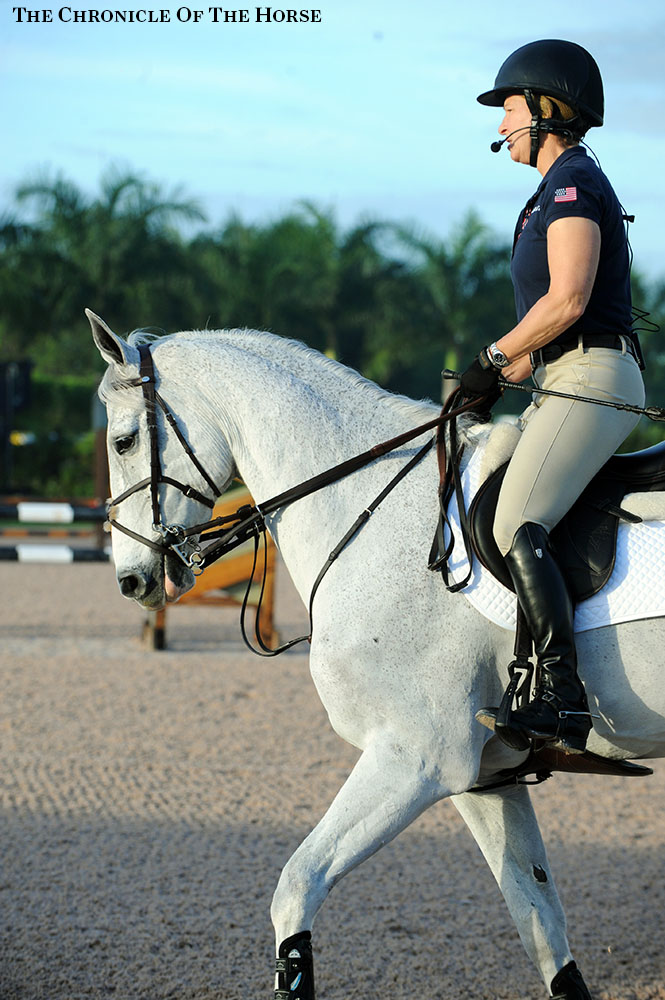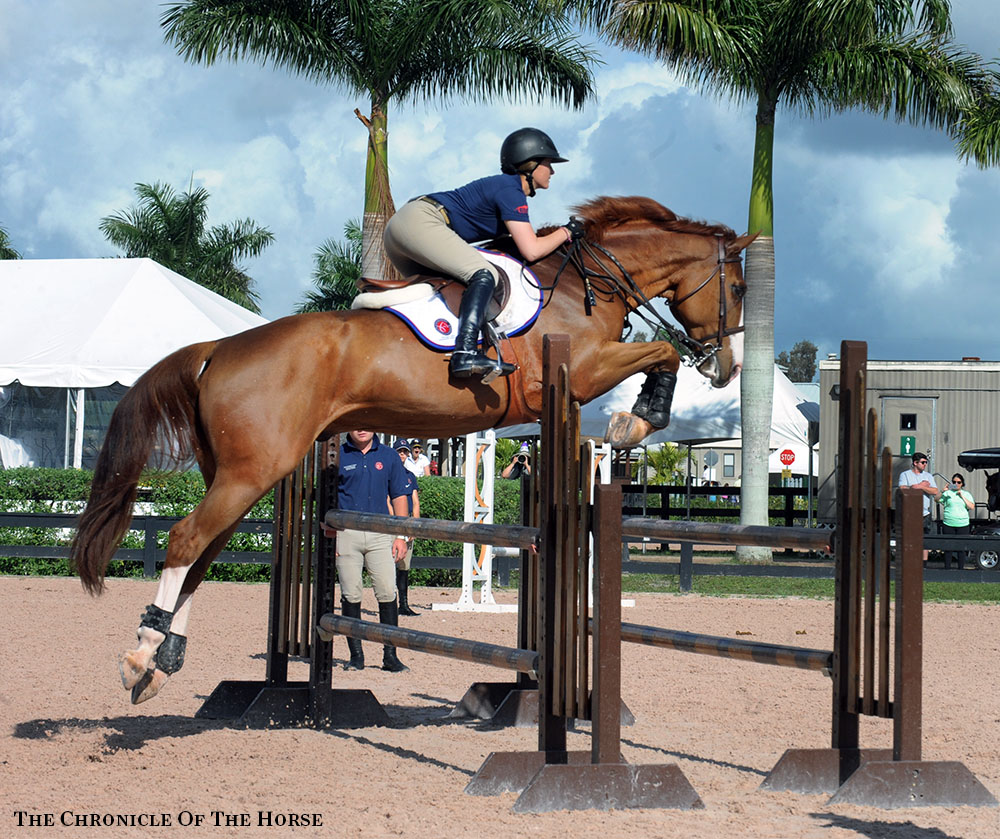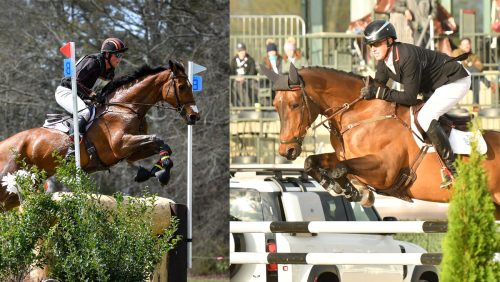Beezie Madden is a tough act to follow.
On the second day of the 2016 George H. Morris Horsemastership Training Session, Beezie Madden saddled up for a pre-clinic demonstration of flatwork and gymnastics.
Working with a horse coming off a layoff, Madden gave a textbook clinic on how to properly school a horse from start to finish, as she intentionally used a horse that needed practice. Surely, each of the participating riders in the clinic learned what would be expected of them in their following sessions and how they could perhaps work through problems they encountered with their mounts along the way.
Building off the previous day’s flat session with U.S. Dressage Young Horse Coach Christine Traurig, Madden further emphasized the importance of building a horse’s topline.
“This horse has a weak topline,” she said, referencing her mount’s layoff. “He’s very scopey, but his weakness is in his shortening. This is where the gymnastics come in.”
Madden took her time working the horse on the flat with several changes of direction, half passes, shoulders in and haunches in, before taking him through several gymnastic exercises, first with poles and then over a series of verticals. She worked in transitions throughout and also incorporated different sets of strides in the combinations: three strides to four strides and four strides to three strides.
“The goal is for him to do it with his frame and balance staying the same,” she said. “When you’re working with a grand prix horse, he should do that and be like an accordion.”
She then incorporated a five-stride line of oxers and a water jump, an obstacle she said her mount had not seen in over a year.
“Show jumping is a sport of concentration,” she said. “Every horse can jump the jumps. The real test is if the horse can jump the jumps in a spooky environment and the tricky distances.”
Many of the riders received their invitations to the clinic based on their accomplishments in the equitation ring, and Madden explained how the lessons the riders learned in that discipline will aid them immensely as they take the next step in becoming professional trainers and climb the ranks in the sport of show jumping.
“In the equitation, you worked on balance and rhythm, not just to win in the equitation,” she said. “The smoother it all is, the less distracted the horse is and the more he can concentrate on his job.”

Madden narrates her demonstration.
Photo by Catie Staszak
Straightness and Position
Madden brought George Morris with her when she returned to instruct the first group of riders later in the morning.
Well, sort of.
Madden held up a talking George Morris action figure and made her introduction.
“I brought a little George with me so that he can have a presence here,” she said. “I’m going to put him in his usual spot in the golf cart!”
That was the extent of the humor. Then things got serious.
Madden warmed the riders up on the flat, incorporating lots of half passes, shoulders in, haunches in and changes of direction, repeating many of the exercises she had demonstrated earlier in the morning. As the riders worked in pole exercises, Madden put an emphasis on straightness as the riders cantered the first pole, trotted the second and cantered the third before switching directions and repeating the drill.
ADVERTISEMENT
“I want straightness, even through the lead change,” she said, “not over-bending and crookedness. It becomes a habit. People like to just bend the horses in the direction that they want.”
Even though many of the riders are phasing out of the equitation, Madden still pointed out weaknesses in the riders’ positions.
“Make your back stronger in the transitions,” she instructed Tori Colvin. “You’re doing the exercise nicely, but when you roach your back it makes you weak. You want to be able to do this on any horse.
“If your shoulder gets ahead of your hips, it puts you in a weak, vulnerable position,” she added to the group.
Before jumping, the riders cantered through the poles, adjusting the amount of strides the horses fit in between the obstacles.
“Lucy’s [Deslauriers] horse isn’t a fan of this, so she’ll be happy when we put the jumps in the cups,” Madden said.
Deslauriers’ wishes were granted about 40 minutes into the session.

Tori Colvin and Whisper Z
Photo by Catie Staszak
From Students To Teachers
When the jumps went up, Madden had the riders practice a course that required them to adjust their horses’ strides through the gymnastic before incorporating a change of direction and two inside turns over a diagonal oxer.
“Times allowed are tight. Jump-offs are fast,” Madden said. “You have to make those turns natural to you.”
The final course incorporated all of the elements. It began with the five-stride line of oxers. Then the riders navigated the water, turned directly to a combination with landing rails and then repeated the first line—but adding an additional stride—before a final halt.
Madden emphasized that in order to jump a successful course, the riders had to prepare their horses properly in the corners.
“Anything you can do in the warm-up to prepare yourself is going to make you better,” she said. “The exercise starts as soon as you pick up the canter.”
“Set yourself up for success,” she repeated. “Set yourself up. Set your horse up.”
That meant different things for different riders. Kelly Cruciotti rode a strong horse, and Madden pushed her to “fight for more room without fighting so much with your horse.” Eve Jobs’ mount was much quieter, and Madden instructed her to get him in front of her leg; she also challenged Ransome Rombauer to up the pace and gallop. She guided Deslauriers through the combination with landing rails to make her at-times nervous horse more comfortable with the exercise, and she made Daisy Farish finesse her turns. On the flat, she schooled Mitch Endicott’s horse, at 7 years old the youngest in the clinic, through half passes.
Madden stressed that the riders’ focuses needed to change from being students to being teachers.
“You’re making the transition from being students and learning to being able to teach your horse,” she said. “Before, you needed the education and a way to develop your skills. Now, you’re going to need to be responsible and the horse’s career is going to become the most important part of your program. You’re still going to develop your skills, but the development of your horse’s skills is going to become more important.”

Lucy Deslauriers and Hamlet
Photo by Catie Staszak
ADVERTISEMENT
Preparing For A Big Event
“The goal of today is to prepare the horses for an event, in this case a Nations Cup format tomorrow,” Madden said, referencing the final session of the clinic, a Nations Cup-style event Friday morning, which will be led by Madden’s American teammate and fellow Olympic gold medalist Laura Kraut.
There was a lot of repetition. Difficult halts throughout the session tested the riders’ control of their mounts. Jumping in in three strides and out in five strides tested the horses’ rideability. Schooling over the water jump made sure there would be no surprises the next day.
“If I were preparing a horse for a Nations’ Cup, I wouldn’t school over the water the day before, but for the purposes of this event, we only have three days, and we have to prepare them for what they are going to see tomorrow,” Madden said.
Madden built a makeshift water jump on the far left side of the arena, adjacent to the rail, with a tarp, bushes and a single PVC pipe with tape to teach the horses to jump over the entire obstacle.
“Create your stride in the corner,” she said. “Don’t chase the horse. Don’t treat it like it’s anything scary.”
That led into another key point of Madden’s instruction: Work with the horse, not against the horse.
“You correct the root by correcting your position,” she told Cruciotti. “Don’t get rough with the half-halt. Make your position better.”
True to the clinic’s name, it wasn’t just a riding lesson. It was a lesson in horsemanship.
“Engage in positive reinforcement training,” she said. “Change the pattern up a little. Keep in mind what you are teaching your horse.
“Details matter,” she added. “Everything you do, even in the barn, you are training your horse in discipline.”
Beezie On…
Contact: “Keeping the connection means coordinating the aids, when the horse stays right between your hand and leg. There should be equal roundness in the neck as in the body.”
“Connection means light contact, not pulling. Don’t plant your hands; bend your elbows.”
Reactivity: “Your horse needs to be respectful and ready to respond to the aids but not be afraid of the aids. Your horse should respond immediately to the amount of pressure that you want to apply.”
“Once a horse is more reactive to your leg, it’s so much easier to do everything.”
Adjustability of the Rider: “The correct position isn’t always the same position. You have to be able to adjust.”
Follow along with all of the Chronicle‘s reports from the 2016 George H. Morris Horsemastership Training Sessions.














